Boosting Restaurant Efficiency with Smart Kitchen Layouts
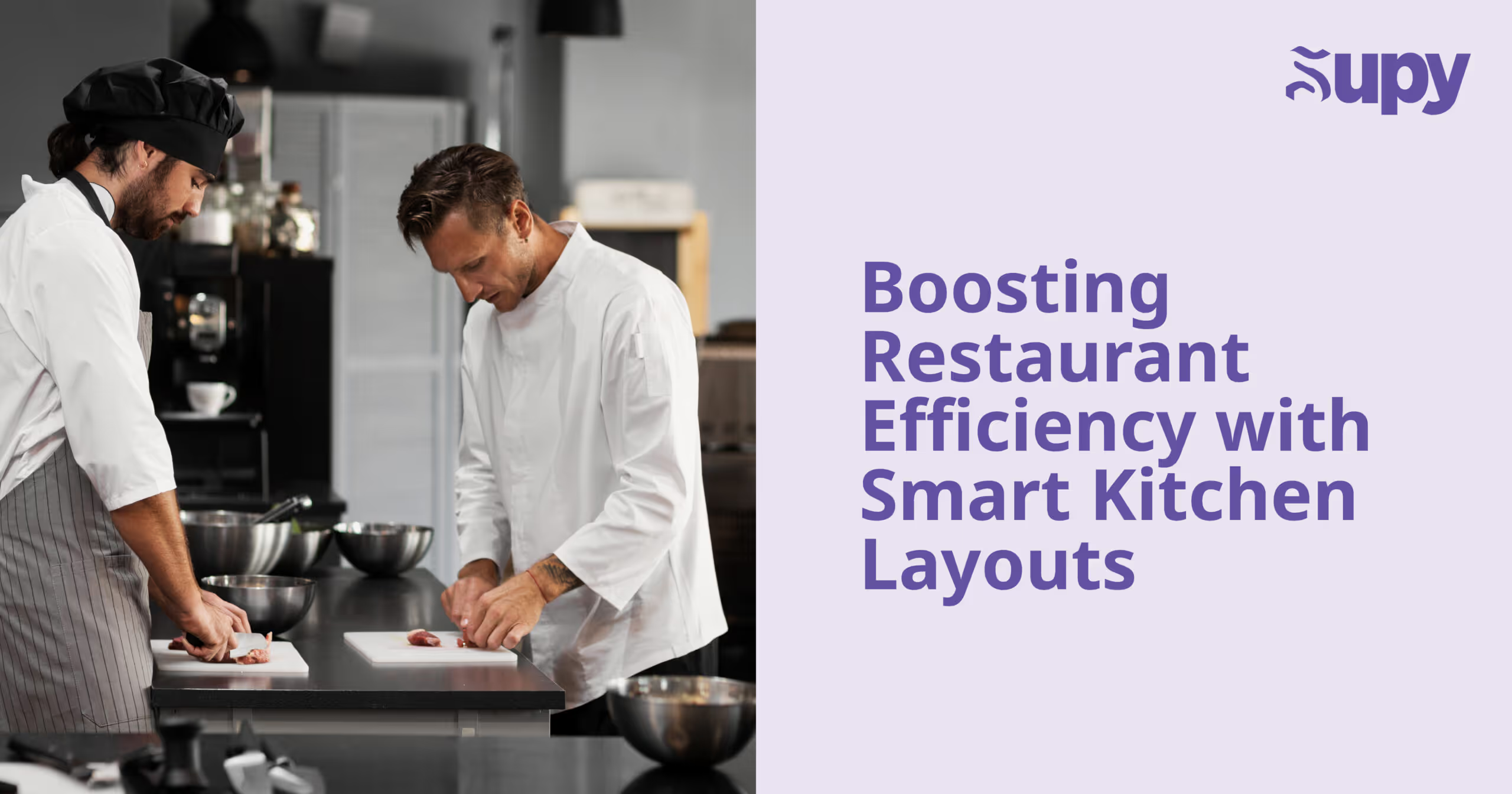
Running a commercial kitchen in an F&B setup means ensuring everything moves like clockwork, especially during peak hours. With staff working around flames, hot liquids, and sharp knives, a poorly planned layout in the back of the house can quickly become a safety hazard. Overcrowded prep stations, long treks between storage and cooking areas, or bottlenecks at the plating station can disrupt service and frustrate your team, leading to delayed orders and unhappy customers.
These challenges emphasize the importance of a smart, well-thought-out kitchen design. A carefully planned space can transform potential chaos into smooth, streamlined operations, enhancing productivity and safety for your staff. With the right smart kitchen layout, every shift can run seamlessly, even on the busiest days.
In this blog, we’ll look at:
- How Does Kitchen Layout Improve Restaurant Efficiency?
- Essential Smart Kitchen Technologies For Restaurant Chains
- 5 Common Smart Kitchen Layout Ideas
- Steps and Considerations When Designing Your Smart Kitchen
- Innovations in Smart Kitchen Designs You Should Know About
- Conclusion
- About Supy
If you’re building a new kitchen or planning to revamp an existing one, this guide will show you how smart kitchen layout choices can transform your operations and keep your team working at their best.
1. How Does Kitchen Layout Improve Restaurant Efficiency?

A successful restaurant depends on more than just great food. It also relies on a kitchen that operates efficiently. The right layout can streamline workflows, enhance safety, and maximize productivity, making all the difference during a busy service.
Here are the five most important ways a well-planned kitchen layout improves efficiency:
- Better Time and Cost Management: An efficient layout ensures that everything your team needs is within easy reach, reducing unnecessary trips and speeding up meal prep. Minimizing wasted movement and optimizing equipment placement lets your staff work faster, leading to quicker order turnaround and lower operational costs.
- Seamless Workflow Coordination: A well-organized kitchen layout promotes a logical flow of tasks, from food prep to cooking to plating. When each workstation is arranged to minimize bottlenecks and overlaps, your team can operate smoothly. This coordination is key to delivering meals quickly and consistently.
- Enhanced Safety Measures: A thoughtful design can greatly reduce the risk of accidents in a high-stakes environment full of hot surfaces and sharp objects. Keeping high-traffic paths clear and separating hazardous areas from main work zones helps protect your staff from injury and keeps operations running safely and efficiently.
- Improved Team Communication: A clear, open layout makes it easier for staff to communicate. When chefs, cooks, and servers can easily see and hear one another, there’s less confusion, fewer mistakes, and a more synchronized effort. Effective communication boosts efficiency and ensures that every order is handled smoothly and accurately.
- Optimal Food Safety and Hygiene: A strategic layout helps enforce food safety standards by keeping raw and cooked items separate and making cleaning supplies easily accessible. This reduces the risk of cross-contamination and keeps your kitchen hygienic, which is essential for both customer satisfaction and regulatory compliance.
2. Essential Smart Kitchen Technologies For Restaurant Chains
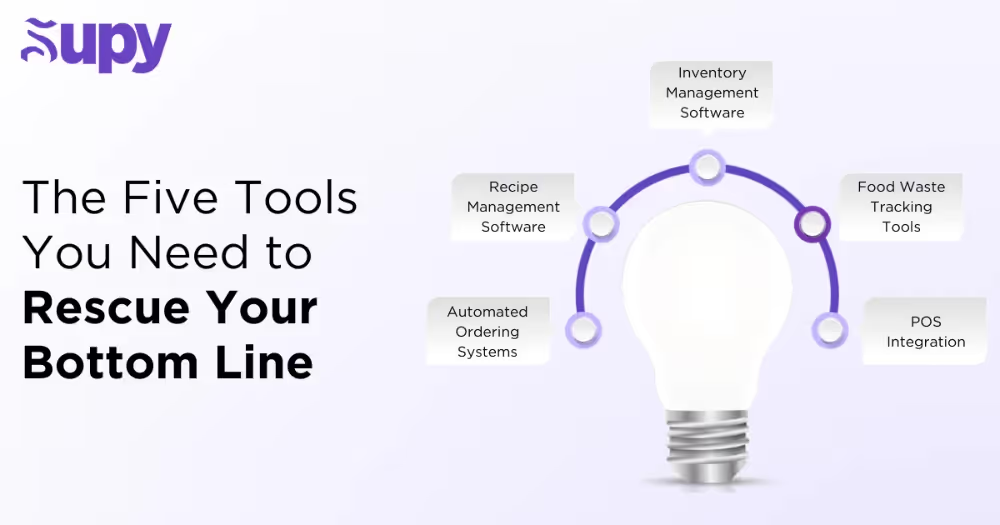
Smart kitchen tech is what makes your kitchen layout truly smart and efficient. Integrating advanced features and gadgets boosts productivity, streamlines operations, and improves communication between your team members.
Here are some must-have smart features and tools for a modern, high-functioning kitchen:
- Kitchen Display Systems (KDS): These built-in touchscreen systems replace traditional paper tickets, allowing seamless communication between the front-of-house (FOH) and back-of-house (BOH). KDS reduces errors, speeds up ticket times, and keeps your workflow organized.
- Automated Cooking Equipment: Smart kitchen appliances like smart ovens and programmable fryers ensure consistency by pre-setting specific temperatures and cooking times. These smart kitchen tools reduce the need for constant monitoring and free up your staff to focus on other tasks. Even a smart coffee maker can be a valuable addition, ensuring perfectly brewed coffee every time with minimal effort.
- Inventory Management Software: Inventory management technology keeps track of your stock levels in real-time, helping you reduce waste and efficiently manage reorders. With smart features integrated into your inventory system, you can maintain the right amount of ingredients to meet demand and avoid running out of key items.
- Temperature Monitoring Systems: Wireless sensors monitor the temperature of your refrigerators, freezers, and even specific storage areas. These smart kitchen gadgets send alerts if temperatures fall out of the safe range, helping you prevent food spoilage and maintain high food safety standards. For example, a smart meat thermometer can be used to check that meats are cooked to the proper temperature, adding an extra layer of safety and precision to your kitchen operations.
- Smart Ventilation Systems: Advanced hoods with smart features automatically adjust ventilation levels based on the amount of heat and smoke in the kitchen. This not only improves air quality but also saves energy. Pair this with efficient food processors and other smart kitchen appliances to create a more productive and comfortable working environment.
3. 5 Common Smart Kitchen Layout Ideas
A smart kitchen layout can make all the difference in keeping operations smooth and efficient. Many restaurant chains carefully choose layouts based on their service style. For example, Chipotle uses an assembly line layout for fast, customized orders, while high-end spots like Nobu use open kitchens to enhance the dining experience.
Here are popular kitchen layout ideas that you will find in most restaurants:
1. Assembly Line Layout
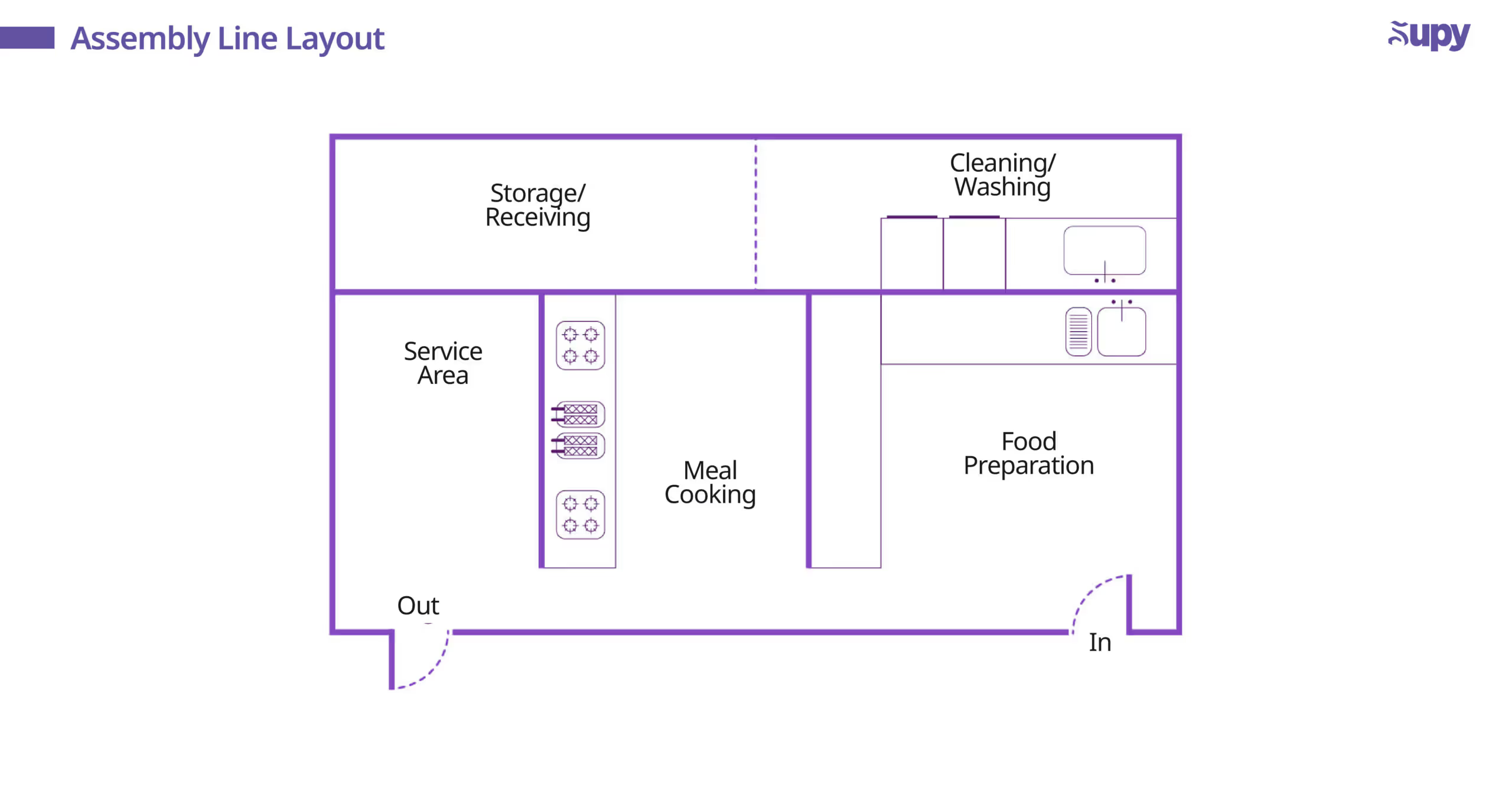
The assembly line layout organizes the kitchen in a straight line, with each station dedicated to a specific part of the food preparation process. Staff move step-by-step along this line to assemble dishes. This design is perfect for high-volume, consistent production. It minimizes movement by keeping everything within arm’s reach, which reduces prep time and ensures a steady flow of orders. This setup is ideal for busy shifts when every second counts.
Ideal For:
Best for restaurants that need to serve a large number of identical dishes quickly.
- Fast-food restaurants
- Pizza chains
- Cafeterias
- Quick-service eateries
In an assembly line layout, make sure each station has all the necessary tools and ingredients at hand to cut down on movement and speed up service.
2. Zoning Layout
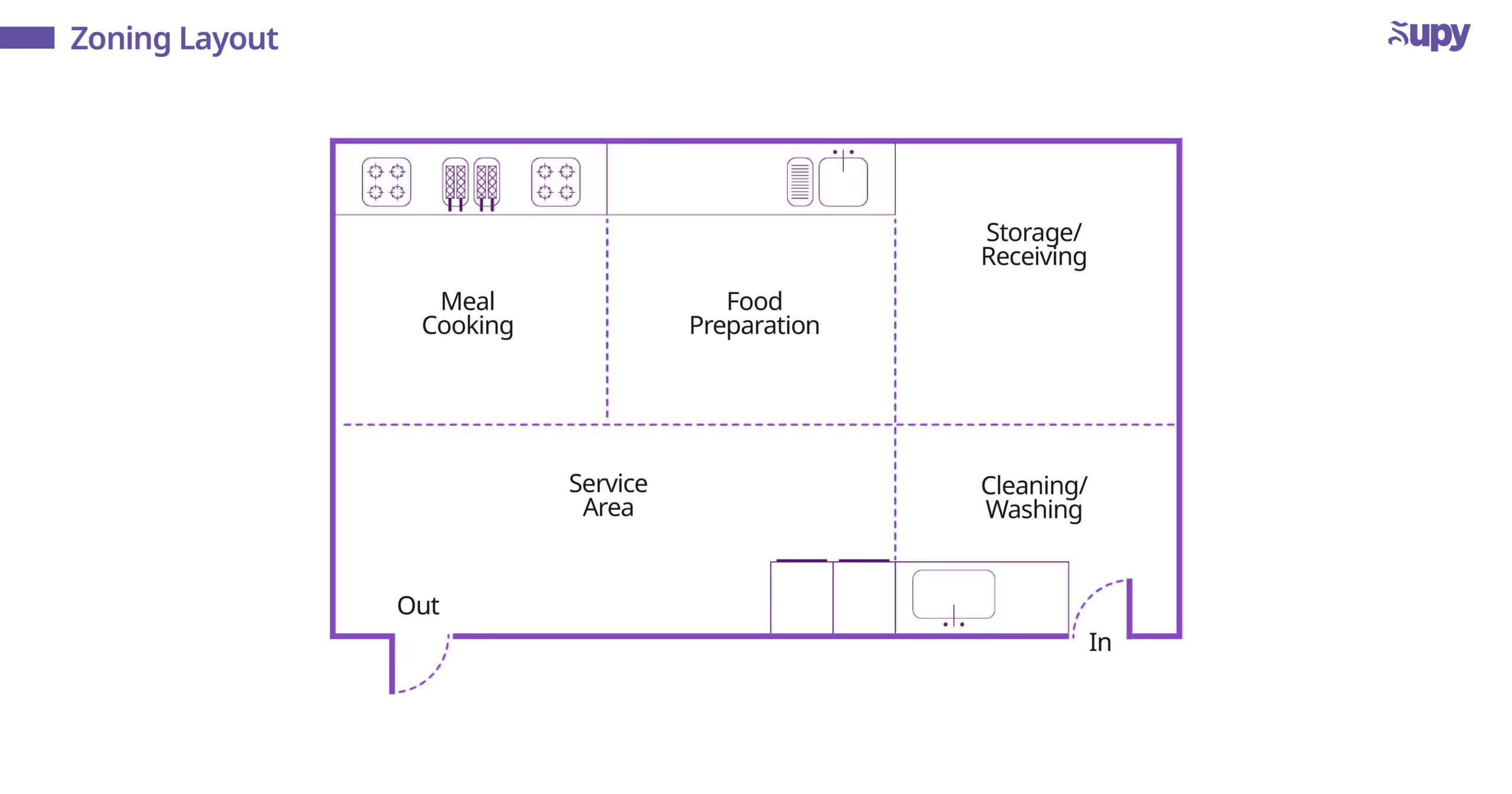
The zoning layout splits the kitchen into separate zones, each dedicated to a specific function like prep, cooking, baking, or dishwashing. This setup keeps tasks organized, minimizes cross-contamination, and allows staff to stay focused on their respective areas without interference. It’s an excellent choice for maintaining quality and ensuring different dishes are prepared efficiently, even in kitchens that handle a wide range of menu items.
Ideal For:
Best suited for restaurants with diverse menus that require separate work areas to avoid overlap.
- Restaurants with diverse menus
- Bakeries
- Full-service dining establishments
- Catering services
Clearly label each zone and provide enough space between areas to maintain smooth traffic flow and ensure safety during busy shifts.
3. Island Layout
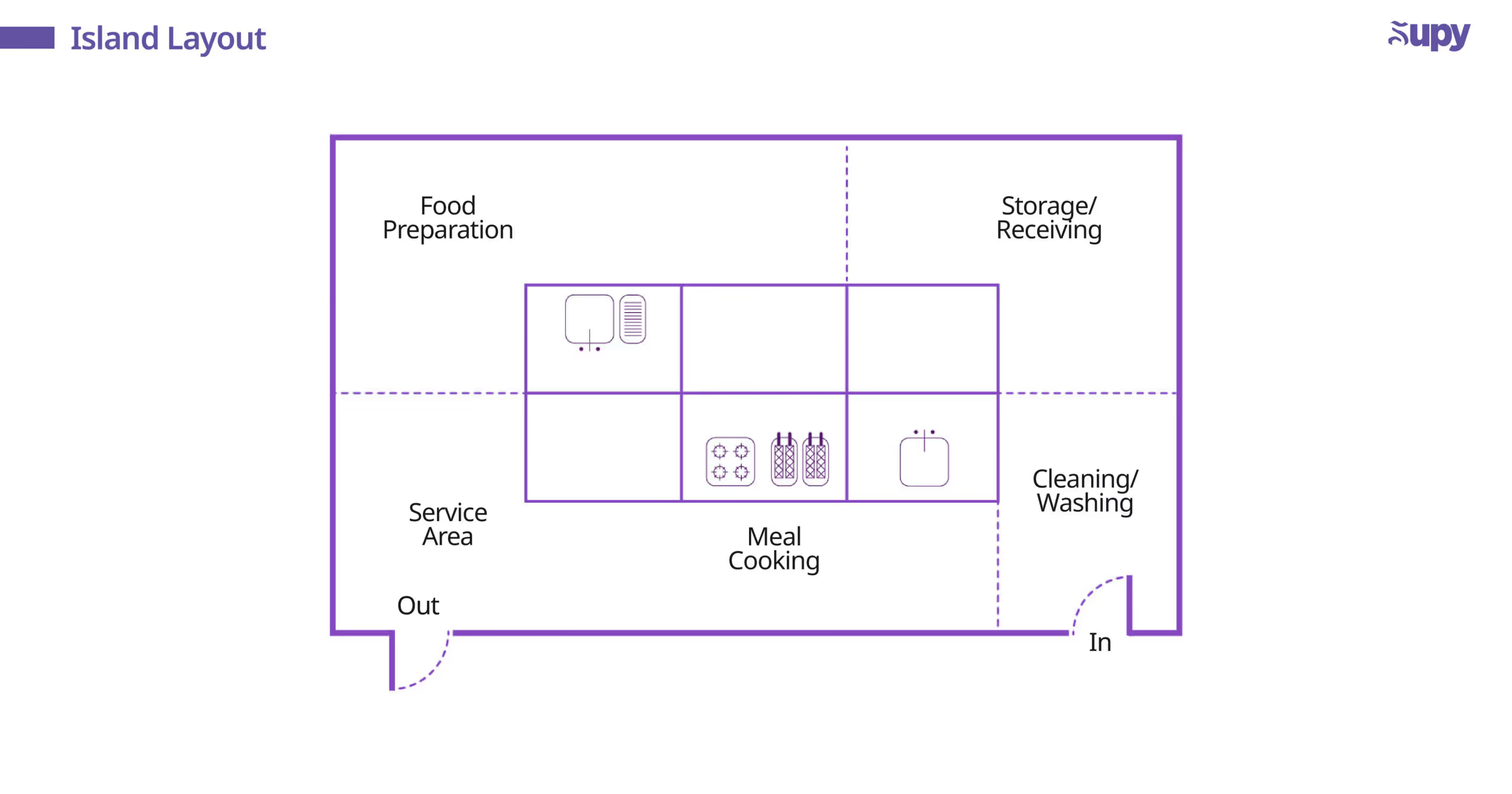
In an island layout, the main cooking station sits in the center of the kitchen, surrounded by prep and storage areas. This central hub allows for better communication and visibility which makes it a strong choice for open kitchens or collaborative work environments. The island design helps staff easily move between stations, fosters teamwork and is great for interactive settings where chefs can showcase their skills.
Ideal For:
Perfect for settings that emphasize teamwork and need an efficient flow of communication.
- Fine-dining restaurants
- Open-kitchen concepts
- Culinary schools
- Large-scale catering venues
Ensure the central island is well-equipped and keep the surrounding pathways wide to avoid congestion, especially when multiple chefs are working at once.
4. Galley Layout
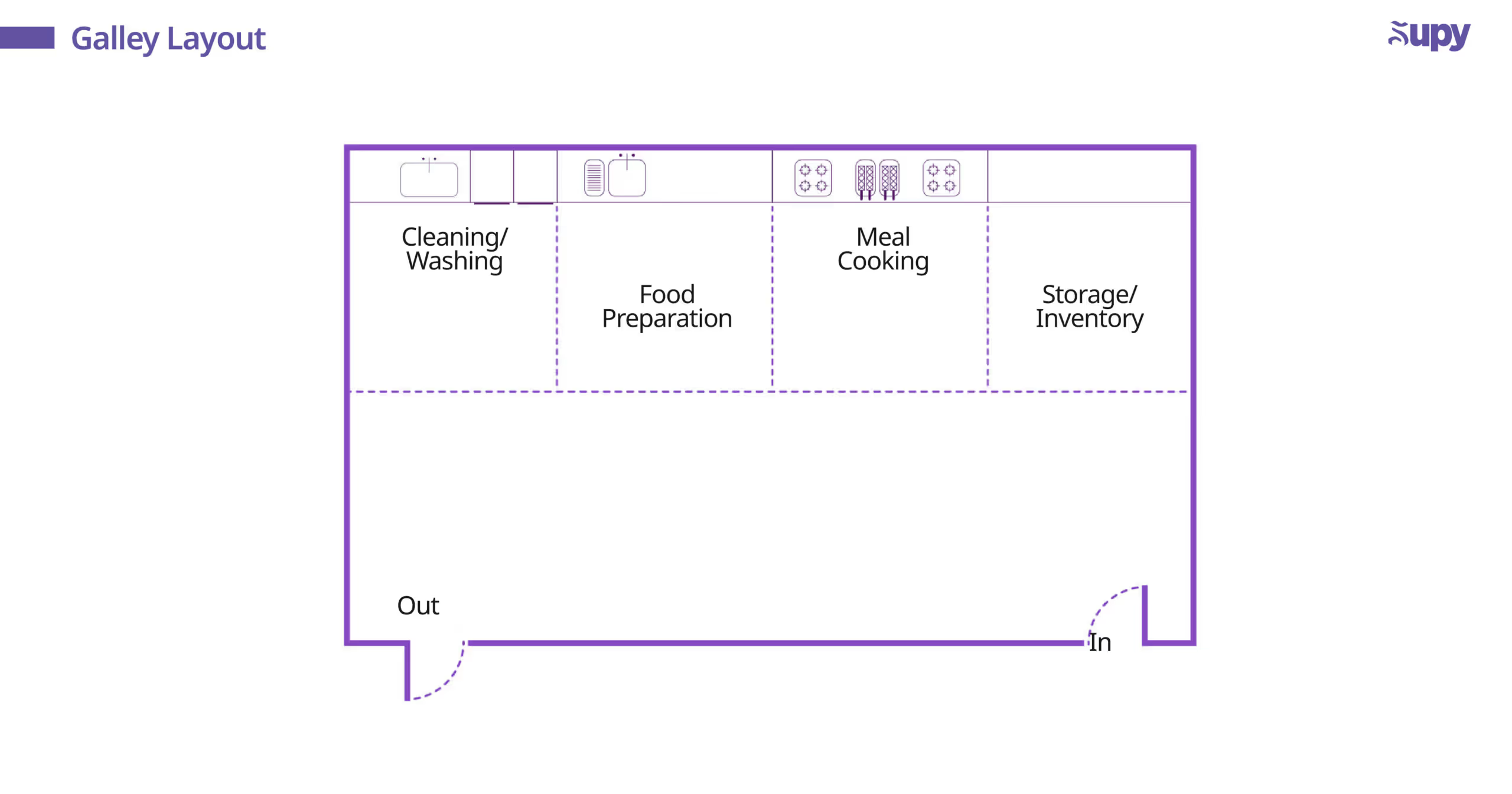
The galley layout features two parallel workspaces with a central aisle. It’s efficient and compact, making it a go-to choice for small kitchens where maximizing every inch of space is essential. One side of the galley is typically used for food prep, while the other handles cooking. This layout reduces the time spent moving back and forth and keeps everything within easy reach. It provides an effective setup for limited-space environments that still require high functionality.
Ideal For:
Ideal for small, space-constrained kitchens that still need to operate at full efficiency.
- Food trucks
- Small urban restaurants
- Cafés
- Compact bistros
Utilize shelves or hanging racks to maximize vertical space, keeping essential tools and ingredients within easy reach to reduce clutter and streamline operations.
5. Open Layout
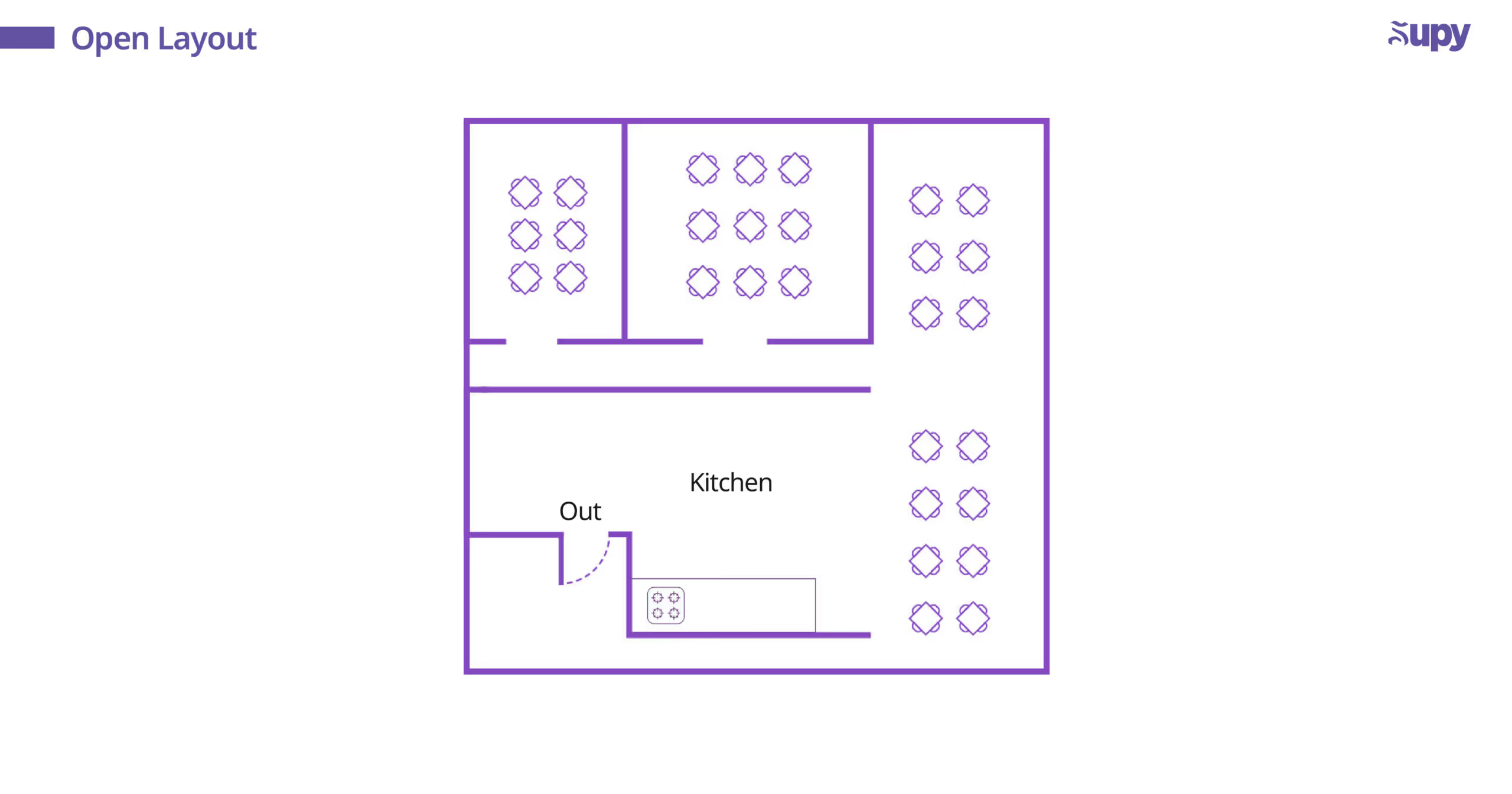
The open layout connects the kitchen and dining area, allowing customers to see the cooking action firsthand. This setup is visually engaging but needs strategic planning to manage noise, odors, and overall presentation. Open layouts offer entertainment value and also motivate kitchen staff to stay organized and perform at their best since everything is on display for diners.
Ideal For:
Great for restaurants that want to provide an engaging dining experience where guests can watch the cooking process.
- High-end restaurants
- Bar-and-grill establishments
- Live cooking concepts
- Themed dining experiences
Invest in high-quality ventilation systems and soundproofing to ensure the dining area remains comfortable and pleasant for guests, even during the busiest service times.
4. Steps and Considerations When Designing Your Smart Kitchen
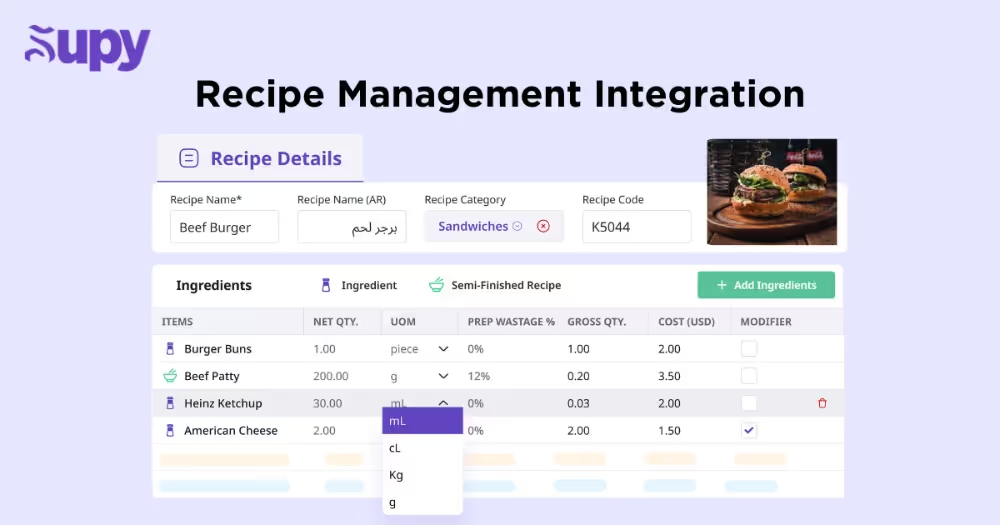
Designing an efficient commercial kitchen is about more than simply placing equipment wherever it fits. Each decision should improve workflow, boost safety, and maximize space utilization. Here’s a guide to creating a kitchen layout that truly supports your restaurant’s unique needs.
1. Understand Your Menu and Service Style
Your menu will dictate the equipment, storage, and layout of your entire kitchen.
For instance, a restaurant serving a high volume of grilled items will need ample grill space and ventilation, while a bakery will require ovens and large prep areas.
Assess the complexity and speed of your recipes and cooking methods and align your kitchen design accordingly. This ensures your chefs have the right kitchen appliances and setup to deliver quality dishes efficiently.
2. Measure and Plan Your Space Thoughtfully
Before designing, take detailed measurements of your kitchen area, including windows, electrical outlets, and fire escape doors. The standard ratio for dining room to kitchen space is often 60:40, but this can vary based on your restaurant type and available area. Consider how any outdoor space might influence your design, especially if you plan to use it for additional storage or seating.
For example, If your restaurant has a total floor area of 4,000 square feet, you might allocate 60% (2,400 square feet) to the dining area and 40% (1,600 square feet) to the kitchen. his balance helps maximize customer seating, provided the kitchen has enough space for efficient operations, including storage for frozen foods and room for essential appliances like the fridge and oven.
3. Focus on Workflow and Efficiency
Think about how ingredients, staff, and equipment will move throughout the kitchen. Design your layout to minimize unnecessary movement and prevent bottlenecks. Arrange workstations in a logical order that matches the cooking process—from storage to prep, cooking, plating, and serving.
For example, place fridges near prep stations to easily store and retrieve perishable and frozen foods, and keep cooking areas close to the plating station to speed up order completion. Consider using a connected kitchen app or a kitchen display system (KDS) to streamline communication between front-of-house (FOH) and back-of-house (BOH) teams, reducing ticket times and errors.
4. Prioritize Safety and Health Compliance
Safety and hygiene are crucial in a commercial kitchen. Workstations should be spaced to prevent staff collisions, with pathways wide enough for easy movement. Investing in a high-quality ventilation system helps manage heat and remove airborne pollutants.
Familiarize yourself with local health and safety codes and work with organizations like OSHA or your local health department so your kitchen meets all regulations. This includes proper food storage, waste disposal, and fire safety measures. Designate separate areas for raw and cooked foods to prevent cross-contamination and make sure cleaning supplies are readily accessible for staff.
5. Incorporate Proper Storage Solutions
A well-thought-out storage plan can make or break your kitchen’s efficiency. Account for all storage needs, from dry goods in the pantry to refrigerated and frozen foods.
In small kitchens, use vertical storage solutions to make the most of limited space. This could include installing shelves that reach up to the ceiling for storing less frequently used items, freeing up valuable counter space for everyday tasks. Ensure your kitchen appliance storage is organized and easy for staff to use.
6. Designate Functional Areas for Specific Tasks
Separate areas for food prep, cooking, cleaning, and service will keep your kitchen running efficiently. Ensure each food prep station has adequate counter space, proper cutting tools, and easy access to nearby sinks for washing.
Position cooking stations based on your menu’s requirements, equipping them with the right appliances like ovens and safety measures. The dishwashing area should be away from the food prep and cooking zones to maintain cleanliness and order, addressing your kitchen’s current needs.
7. Consult Your Chef and Team
Your chef and kitchen staff know the ins and outs of the menu and daily operations better than anyone else. Collaborate with them to understand what equipment and layouts will work best and where to cut back to save on costs. Their insights can help you avoid investing in unnecessary tools and ensure the entire kitchen is tailored to the actual needs of the team.
They can advise on optimizing cooking methods and selecting the most useful kitchen gadgets and smart gadgets, like kitchen display systems or automated cooking tools, to enhance efficiency and productivity.
5. Innovations in Smart Kitchen Designs You Should Know About
To stay ahead of the competition and improve your restaurant’s efficiency, it’s important to consider the latest advancements in smart kitchen design. These improvements combine flexibility with practical technology, making your kitchen more streamlined and adaptable.
Here are five impactful developments worth exploring:
- Cloud Kitchens: Cloud kitchens maximize space and efficiency by using tech advancements like automated cooking equipment and app-based order management systems. These setups are ideal for handling high delivery volumes smoothly and effectively.
- Modular Kitchens: Flexible workstations and equipment that can be easily reconfigured to suit changing menus or seasonal needs. Incorporating smart gadgets and connected appliances can help monitor energy use and optimize performance.
- Automated Prep Stations: High-tech stations equipped with smart kitchen tools like robotic arms or automated food processors, reducing the need for manual labor and ensuring that food prep is consistent and efficient.
- IoT-Enabled Appliances: Smart fridges, freezers, and other kitchen appliances that offer real-time monitoring and send alerts through connected apps. These features help prevent food spoilage, track inventory, and ensure everything is running smoothly.
- Eco-Friendly Designs: Kitchens designed with energy-efficient equipment, smart ventilation systems, and water-saving technologies. These setups support sustainability and integrate waste management practices to benefit the environment and your bottom line.
6. Conclusion
Smart kitchen layouts and technology are making restaurants safer, more efficient, and better at handling the demands of modern dining. Careful planning of your kitchen’s design, using the latest tech solutions, and working closely with your team can create a space that meets your needs now and adapts as your business grows. Investing in these smart strategies will streamline operations, boost productivity, and set your restaurant up for long-term success.
7. About Supy
Having the right tools is just as important as a smart kitchen layout when it comes to running an efficient restaurant. Supy is an inventory management software designed specifically for the hospitality industry. It focuses on optimizing back-of-house operations with features like real-time inventory tracking, automated order processing, and data-driven insights for recipe costing and menu engineering. With Supy, restaurants can cut costs, reduce waste, and maximize profitability.
Centralize your kitchen operations—book a demo today!
FAQ
Why is reducing food costs important for a restaurant?
Reducing food costs is essential for maximizing profit margins, minimizing waste, and improving the overall financial health of a restaurant.
What is a sustainable food cost percentage for a restaurant?
A sustainable food cost percentage typically falls between 28-35%, though it varies by restaurant type and pricing strategy.
How can portion control help reduce food costs?
Portion control prevents ingredient overuse, ensuring that food costs remain consistent and predictable across dishes.
What is the impact of bulk purchasing on food costs?
Bulk purchasing often lowers the per-unit cost of ingredients, but it should be balanced with storage capacity to prevent waste.
How does an inventory management system help reduce food costs?
An inventory system helps track ingredient usage, prevent over-ordering, and reduce waste, thereby lowering overall food costs.
Why is monitoring waste essential for reducing food costs?
Monitoring waste allows restaurants to identify sources of loss and implement waste-reduction practices to save on food expenses.
How can menu engineering reduce food costs?
Menu engineering helps identify high-cost/low-profit items, allowing adjustments in pricing, ingredients, or portion sizes to improve profitability.
What role does staff training play in food cost management?
Training staff on portion control, waste reduction, and efficient food handling can significantly lower food costs by reducing errors and waste.
How does sourcing local ingredients help reduce costs?
Local sourcing often reduces transportation costs and shortens the supply chain, potentially lowering food costs while supporting local economies.
What is the benefit of negotiating with suppliers?
Negotiating can secure better pricing, payment terms, or discounts, helping to reduce overall ingredient costs.
How does monitoring food cost variance assist in reducing food costs?
Monitoring variance identifies discrepancies between expected and actual costs, allowing adjustments to maintain budget targets.
What is the value of a standardized recipe in cost control?
Standardized recipes ensure consistency, control ingredient costs, and maintain portion sizes, which aids in food cost management.
How can seasonal menu adjustments reduce food costs?
Seasonal adjustments allow restaurants to use ingredients when they are most abundant and affordable, helping to lower food costs.
What impact does reducing food waste have on food costs?
Reducing waste minimizes losses, helping restaurants save money by fully utilizing purchased ingredients.
Why is accurate forecasting important for food cost control?
Accurate forecasting helps align inventory with demand, minimizing waste and preventing overstocking of perishable goods.
How can technology assist in reducing food costs?
Technology, such as Supy’s inventory management tools, enables real-time tracking, demand forecasting, and data analysis to optimize purchasing and reduce waste.
What are some best practices for managing perishable inventory?
Best practices include using the FIFO method (First In, First Out), labeling expiration dates, and regularly checking inventory for spoilage.
How does supplier consistency impact food cost management?
Consistent suppliers reduce the risk of unexpected price changes, enabling more predictable food cost management.
What role does menu pricing play in food cost control?
Properly priced menu items ensure profitability by covering ingredient costs and contributing to overhead and labor expenses.
How can cross-utilization of ingredients reduce food costs?
Cross-utilizing ingredients across multiple dishes minimizes waste and allows bulk purchasing of key ingredients, reducing overall costs.







